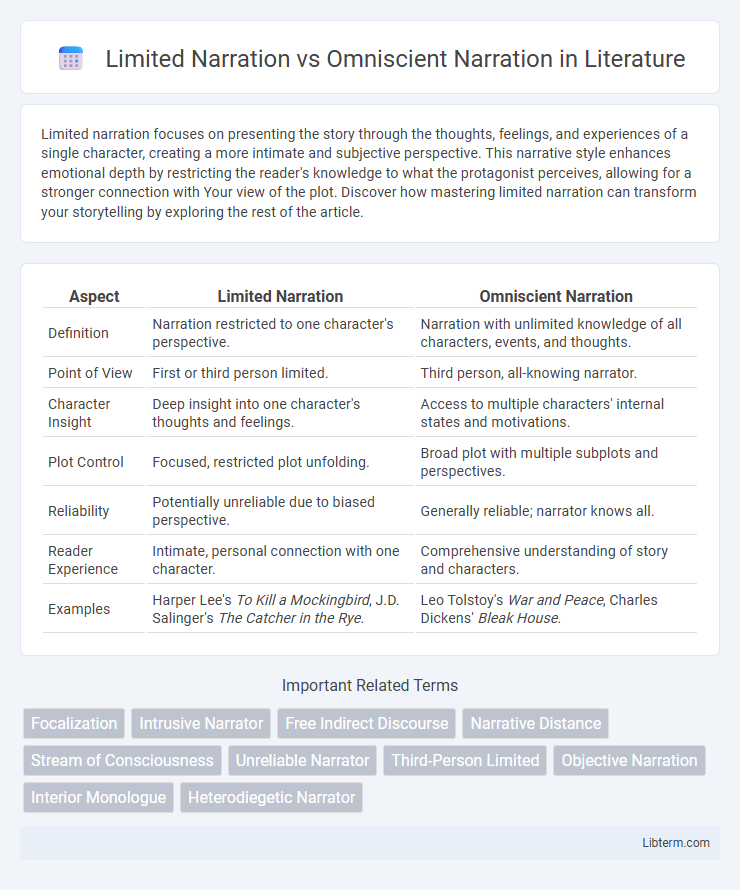Limited narration focuses on presenting the story through the thoughts, feelings, and experiences of a single character, creating a more intimate and subjective perspective. This narrative style enhances emotional depth by restricting the reader's knowledge to what the protagonist perceives, allowing for a stronger connection with Your view of the plot. Discover how mastering limited narration can transform your storytelling by exploring the rest of the article.
Table of Comparison
| Aspect | Limited Narration | Omniscient Narration |
|---|---|---|
| Definition | Narration restricted to one character's perspective. | Narration with unlimited knowledge of all characters, events, and thoughts. |
| Point of View | First or third person limited. | Third person, all-knowing narrator. |
| Character Insight | Deep insight into one character's thoughts and feelings. | Access to multiple characters' internal states and motivations. |
| Plot Control | Focused, restricted plot unfolding. | Broad plot with multiple subplots and perspectives. |
| Reliability | Potentially unreliable due to biased perspective. | Generally reliable; narrator knows all. |
| Reader Experience | Intimate, personal connection with one character. | Comprehensive understanding of story and characters. |
| Examples | Harper Lee's To Kill a Mockingbird, J.D. Salinger's The Catcher in the Rye. | Leo Tolstoy's War and Peace, Charles Dickens' Bleak House. |
Understanding Limited Narration
Limited narration confines the storytelling perspective to a single character's experiences, thoughts, and feelings, enhancing reader intimacy and emotional connection. This narrative style often employs first-person or close third-person point of view, restricting knowledge to what the character perceives, which builds suspense and deepens character development. Understanding limited narration enables writers to create focused, immersive narratives that prioritize personal insight over broad context.
Exploring Omniscient Narration
Omniscient narration grants the storyteller unlimited access to the thoughts, feelings, and experiences of multiple characters, creating a comprehensive and multi-dimensional narrative perspective. This narrative style enriches the story by providing insights into motivations and events beyond the immediate scene, enhancing thematic depth and emotional complexity. Writers employing omniscient narration can seamlessly shift between characters and settings, crafting a cohesive and intricate storyline that engages readers on various levels.
Key Differences Between Limited and Omniscient Perspectives
Limited narration confines the story to the thoughts, feelings, and experiences of a single character, providing a narrow but deep perspective that creates intimacy and suspense. Omniscient narration offers an all-knowing viewpoint, revealing multiple characters' internal states and broader contextual details, enhancing comprehension of complex plots. The key differences lie in focalization scope, depth of psychological insight, and narrative flexibility in presenting multiple viewpoints simultaneously.
Narrative Depth: Insight Into Characters' Minds
Limited narration provides a focused narrative depth by revealing the thoughts, feelings, and perceptions strictly from a single character's perspective, creating intimate insight into their inner world. Omniscient narration offers a broader narrative scope by accessing multiple characters' minds, allowing readers to understand diverse motivations, conflicts, and emotional complexities simultaneously. This contrast shapes the storytelling experience through either concentrated psychological exploration or expansive, multifaceted character insights.
Building Suspense and Mystery with Limited Narration
Limited narration immerses readers in the protagonist's subjective experience, revealing information gradually and fostering suspense through constrained knowledge. By withholding omniscient insights, this technique maintains mystery and heightens emotional engagement as readers piece together clues alongside the character. The restricted perspective creates uncertainty and anticipation, essential elements for building tension in thriller and mystery genres.
World-Building Opportunities in Omniscient Narration
Omniscient narration offers expansive world-building opportunities by providing a comprehensive view of the story's environment, history, and multiple character perspectives, enriching the narrative depth. It allows the author to reveal intricate details and unseen connections within the fictional universe, enhancing immersion and complexity. This narrative style facilitates the creation of a fully realized world where readers gain insight into diverse locations, cultures, and motivations simultaneously.
Emotional Engagement: Reader Experience Compared
Limited narration intensifies emotional engagement by offering a close, subjective view of a character's inner thoughts and feelings, creating a sense of intimacy and immediacy. Omniscient narration broadens the reader's perspective by revealing multiple characters' emotions and motivations, enhancing emotional complexity but sometimes diluting personal connection. Studies show readers often report stronger empathy and deeper emotional resonance with limited narration due to its focused psychological insight.
Authorial Voice in Limited vs. Omniscient Narration
Limited narration confines the authorial voice to a single character's perspective, creating subjective interpretations and selective knowledge that influence the narrative tone and bias. Omniscient narration grants the author unrestricted access to multiple characters' thoughts and broader events, establishing a more authoritative and diverse authorial voice. This contrast shapes how readers perceive reliability, depth, and thematic complexity within the story.
Common Genres for Each Narrative Style
Limited narration is frequently employed in mystery, thriller, and young adult genres to create suspense and closely align readers with a single character's perspective and emotions. Omniscient narration is common in epic fantasy, historical fiction, and literary fiction, offering a comprehensive understanding of multiple characters' thoughts and broader storylines. Each narrative style shapes the reader's experience by controlling the scope of information revealed throughout the plot.
Choosing the Right Narration for Your Story
Choosing the right narration style depends on how deeply you want readers to connect with your characters and understand the plot. Limited narration offers a focused perspective, revealing the story through one character's thoughts and experiences, ideal for building suspense and emotional intimacy. Omniscient narration provides a broader viewpoint, allowing insight into multiple characters and overarching themes, which suits complex narratives requiring comprehensive context and varied perspectives.
Limited Narration Infographic

 libterm.com
libterm.com